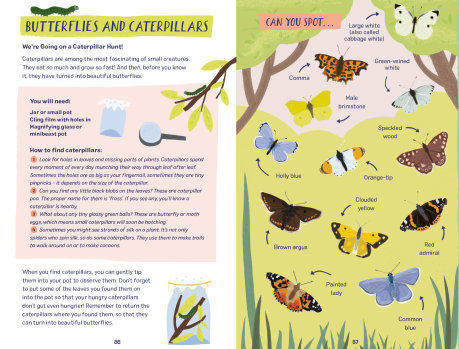All of a sudden I am noticing a lot more butterflies while I am out taking my daily exercise. Yesterday I saw orange tips, a large white, two speckled woods (who seemed to want to follow me!) and a common blue. We are also noticing caterpillars on the nettles. They are most probably the caterpillar of the red admiral or the tortoiseshell as those are the butterflies that like to lay their eggs on nettles.

I have written about nettles before on this blog and also in my nature almanac – so many people hate them because they sting and also because they grow fast and clog up flower beds. But if you can leave a patch of your garden or allotment for nettles, you’ll be helping the butterflies, which has to be a good thing. (And don’t forget that in early spring you can make delicious nettle soup and pesto from the early shoots too!)
Why not take your nature notebook out on a walk and note down how many different types of butterfly you see – and where you see them too? If you go to the Butterfly Conservation website you can find out how to send them the information you have gathered. You’ll be doing a fantastically helpful job!
**
Nature Month-by-Month – a children’s almanac by Anna Wilson, illustrated by Elly Jahnz is published by Nosy Crow and The National Trust and is available to order online.
Your independent bookshop can take orders over the phone and post books out to you, too. Give them a call!
NB The author of this blog accepts no responsibility for the content from links added to this page.





 It was delicious and creamy and the whole family gobbled it up! Here’s the recipe from my almanac, Nature Month-by-Month, in case you’d like to try it. (Although I have put this recipe in the April section of my book, I found that there were already lots of nettles sprouting in my garden. It didn’t take long for me to fill a carrier bag.)
It was delicious and creamy and the whole family gobbled it up! Here’s the recipe from my almanac, Nature Month-by-Month, in case you’d like to try it. (Although I have put this recipe in the April section of my book, I found that there were already lots of nettles sprouting in my garden. It didn’t take long for me to fill a carrier bag.) Here are a few extra facts about stinging nettles. The scientific name for them is Urtica dioica. This
Here are a few extra facts about stinging nettles. The scientific name for them is Urtica dioica. This